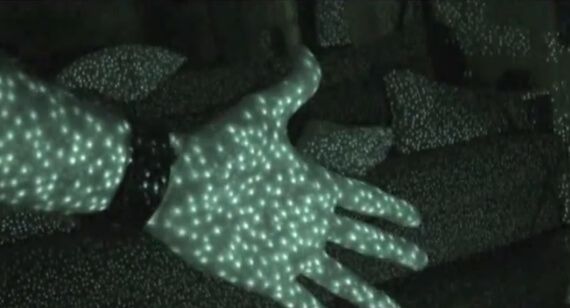Microsoft Kinect is here, and it doesn't look to be going anywhere soon - if Microsoft's promotion of the device is any indication.
With Microsoft expecting the new motion control system to outsell the iPad, it seems like it may be worth our while to try and understand just how Kinect is able to replace the controller with your entire body. It's not too complicated, but it will require some night vision goggles.
While Microsoft is content with simply explaining Kinect as 'tracking your motion,' the truth may be more or less complicated depending on how you see it. The system doesn't magically decipher your location in a room, or take a 2D image of the room and build a virtual 3D space. Kinect uses infrared light to map out an entire playing space, and to read the objects moving within it.
The light is invisible to our eyes, so players are completely unaware that Microsoft's device is constantly shining light into your entire living room. The light bounces back and the system calculates your height, your facial structure - to determine how much you really wanted to pet that tiger.
It can also determine the color of scanned objects.
To get a better idea of the ongoing process, take a look at a Kinect playspace when seen through night vision:
httpv://www.youtube.com/watch?v=nvvQJxgykcU
The video clearly displays the entire room being scanned with tiny dots of light. Different objects at varying distances are painted with a unique layer of light, which Kinect can use to discern motion, map a face, and remove furniture. Also visible in the video is the reason for Kinect's recommended space requirement. The system isn't able to 'paint' the room with light until several feet out from the sensor, marked by an arc along the floor about 6 feet away.
Perhaps now it's easier to grasp just how much data is being calculated at any given moment playing Kinect. Understanding a room-sized light gun isn't incredibly complicated, but keep in mind what else the Kinect does. Analyzing your location in a room seems simple enough, but the device takes that information, and places a skeletal model onto your entire body. Just take a second to imagine how it uses that data to map a human body while sitting down, and it starts becoming clear that the Kinect's price may make a bit more sense than originally thought.
Given the processing required for motion control, the several microphones used to determine your location in the room seems like child's play. Kinect may feature leaping and giggling children in its advertisements, but make no mistake - this technology is absolutely grown-up.
If you have any more insights to share, or questions about the device, join in on the discussion. Perhaps Microsoft can look forward to even more Kinect sales since it's been revealed to be an entire rave in a single device. At the very least, it gives players the opportunity to break out those Call of Duty night vision goggles.

